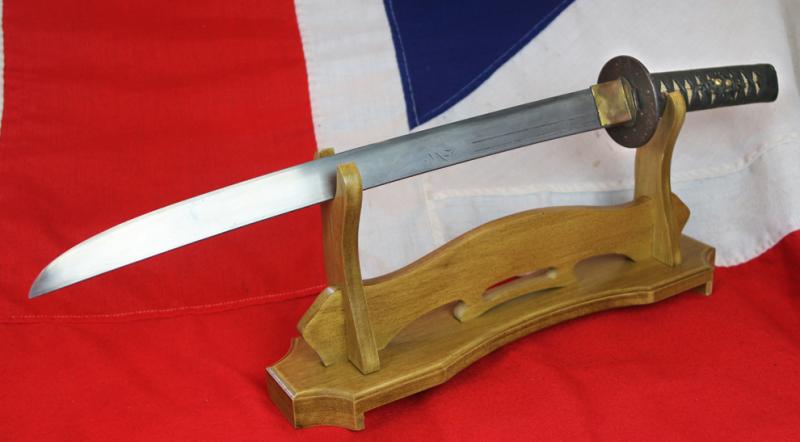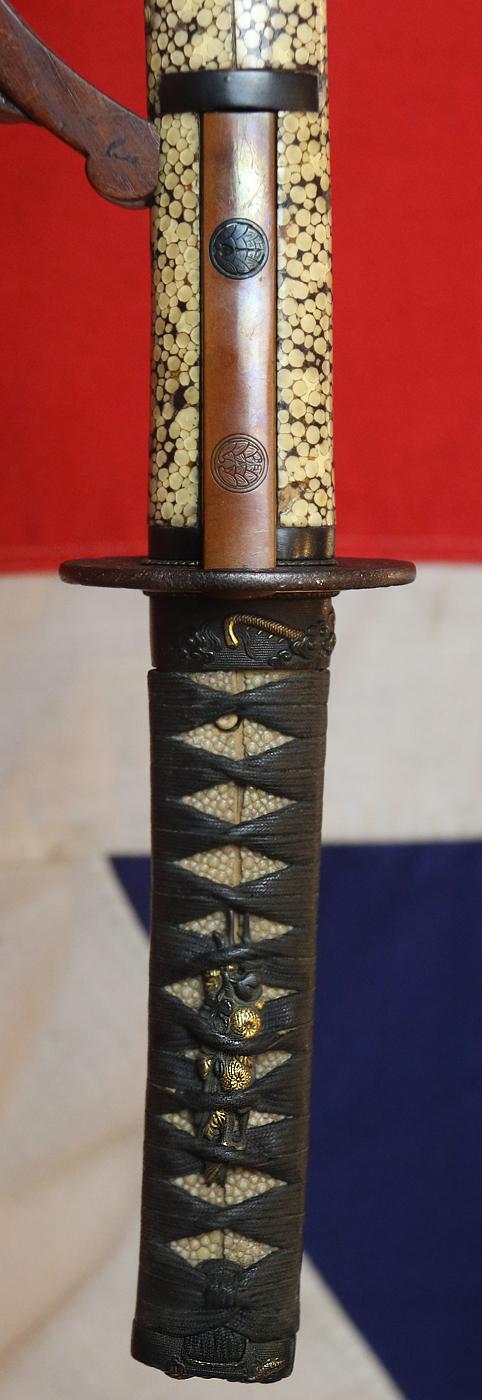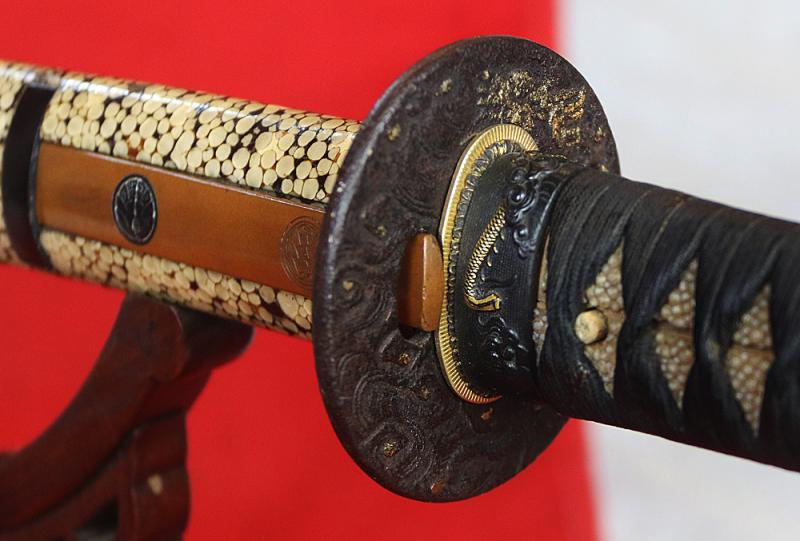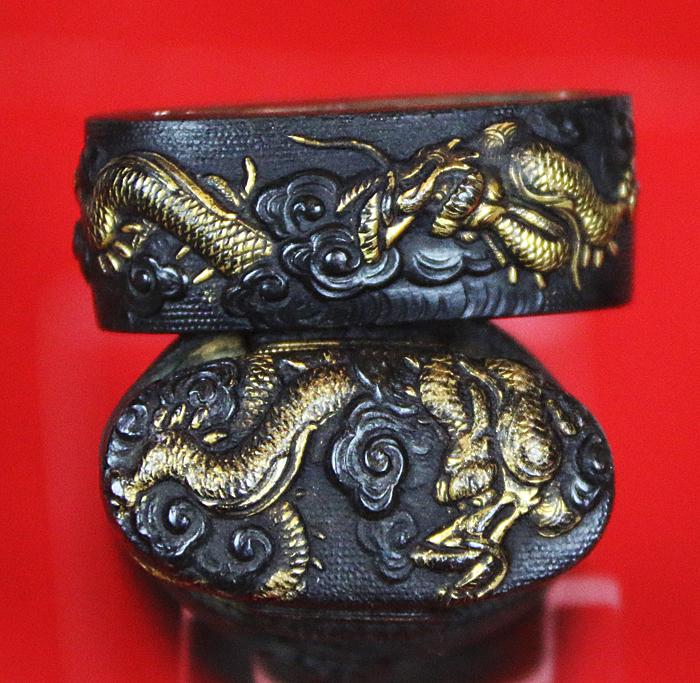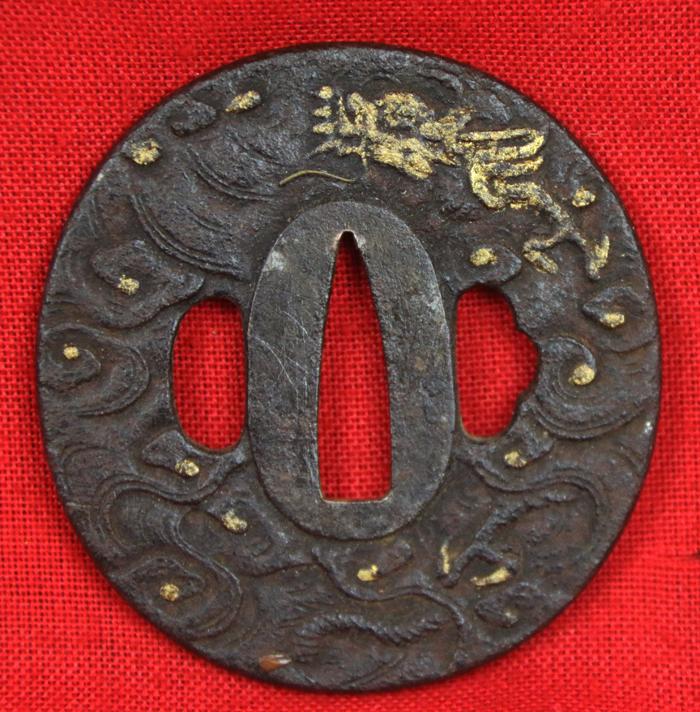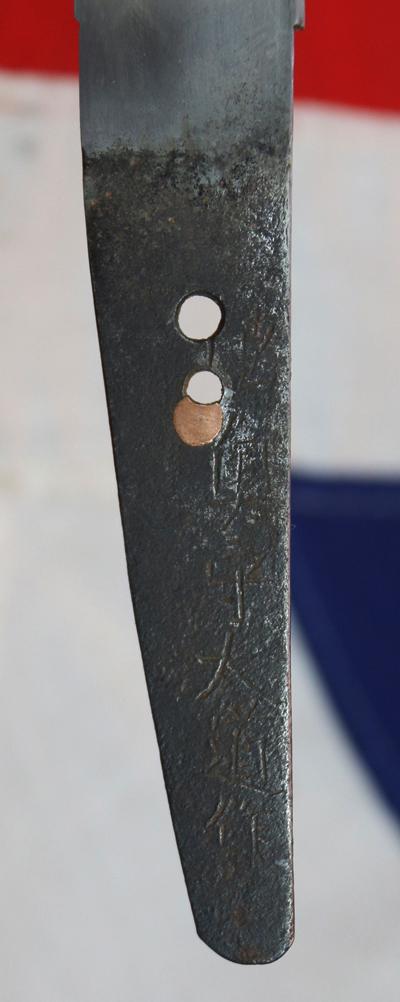An Absolutely Superb, & Signed, Samurai’s Large Sunobi-Tanto or Wakazashi Late Koto to Early Shinto Period. Mutsu no Kami Daido School. Carved Horimono Blade With Bonji, of Fudō-myōō (不動明王), & Buddhist Ken Sword. Nabeshima Clan
The blade, around 400 years old, is very wide and powerful, and has horimono carved to both sides, of ancient Buddhist ken swords, one with a varjira a Buddhist god's lightning creator and the swirling grain in the hada looks absolutely stunning, but it has to be viewed in the right light, with a typical narrow suguha hamon. Beautiful shakudo and pure gold Mino Goto school fuchigashira of takebori water dragon on a nanako ground, with an iron ground matching water dragon tsuba, possibly 3rd or 4th generation Jakushi, from the first half of the 18th century. Chinese-style dragons became a popular subject for Jakushi carvers. Two-toed dragons indicate nothing more than the Jakushi carvers’ bold appetite for artistic license. This piece resembles designs by the second generation, Shiraki Kizaemon, whose works were copied by the third. The founder of the school Kawamura Fukuyoshi, studied painting under Shoyu Itsunen, the Chinese-born abbot of Kofukuji temple in Nagasaki. It appears that Kawamura took the art-name Jakushi (young turf), and collaborated with Kizaemon to transfer his painting ideas into metal, as sword-fitting. Kizaemon and his descendants kept the name Jakushi.”.
It bears the clan mon of the Nabeshima.The clan initially aided Ishida Mitsunari against Tokugawa Ieyasu in the Sekigahara Campaign in 1600. Which is when this fabulous sword dates from. However, they switched sides to support the Tokugawa, who were ultimately victorious, before the campaign had ended, battling and occupying the forces of Tachibana Muneshige, who was thus prevented from contributing directly to the battle of Sekigahara. Though regarded as tozama daimyō ("outside" lords), and assigned particularly heavy corvée duties, the Nabeshima were allowed to keep their territory in Saga, and in fact had their kokudaka increased. The clan's forces served the new Tokugawa shogunate loyally in the years which followed; they remained in Kyūshū during the 1615 Osaka Campaign as a check against a possible rebellion or uprising by the Shimazu clan, and aided in the suppression of the Shimabara Rebellion of 1637. In recognition of their service, members of the clan were granted the prestigious family name Matsudaira in 1648.
Nanako Ji: "fish roe ground" A surface decoration produced by forming very small raised bosses by a sharply struck punch or burin called 'nanako tagane'. Shakudo is the metal most often used, but copper and gold are quite often employed. The harder metals, shibuichi, silver and iron are rarely decorated in this way. The size of the dots vary from 0.04" to 0.008" (25 to 125 and inch) and the regularity of the work is marvelous as the dots must be spaced entirely by touch. The dots are usually arranged in straight lines or in lines parallel to the edge of the piece being decorated, but sometimes in more elaborate patterns. Used on guards since the Momoyama period although the technique existed since much earlier periods. Usually done by specialist 'nanako-shi', but sometimes done by the maker of the guard himself.
A pair of pure gold and shakudo flowering menuki under the tsukaito, and are of wonderful quality, and a stunning shakudo decorated kozuka utility knife with the Nabeshima clan mon of the Daki Myoga ginger plant, and the blade is also fully signed, is set within the saya pocket. The original Edo saya is fabulously decorated with kairagi polished giant rayskin. "Kairagi" means "Ume Blossom Skin".
When you polish the skin, Ume Blossom patterns will appear. Kairagi-same is very rare. The saya is polished samegawa. Polished giant ray skin, samegawa, was, at the time of the Samurai, some one of the most expensive and highly prized forms of decoration to be used on sword scabbards Saya. It was the same material as is used on sword hilts under the binding, but the large and small protruding nodules were hand polished, for hundreds of hours, to create a highly polished flat surface, that was then hand dyed and thus created a decorated scabbard with immense natural beauty, and huge expense for the time. The name Daido is most interesting, his early name is Kanemichi, and he changed to “O”Kanemichi when he received the “O” or “Dai” kanji from the Emperor Ogimachi. Later he called himself “Daido” and then received the title of “Mutsu No Kami” in Tensho 2. It is also believed that he was the personal swordsmith to Oda Nobunaga and the fact that he moved to Kyoto at the same time Nobunaga established his residence in Kyoto seems to support this idea. There are Juyo-Token by him, as well as joint effort works with Horikawa Kunihiro. The Horimono are double edged Buddhist ken straight sword, and a Bonji of 'Fudo' warrior deitie. Fudō-myōō (不動明王) is the full Japanese name for Acala-vidyaraja, or Fudō (o-Fudō-sama etc.) for short. It is the literal translation of the Sanskrit term "immovable wisdom king". The sword engraved on this sword is as a kongō-ken (金剛杵 "vajra sword"), which is descriptive of the fact that the pommel of the sword is in the shape of the talon-like kongō-sho (金剛杵 "vajra") of one type or another. It may also be referred to as "three-pronged vajra sword. The blade 17.5 inches long tsuba to tip, overall 25.5 inches long in saya
Code: 24449
6350.00 GBP


